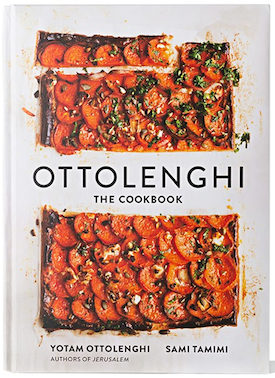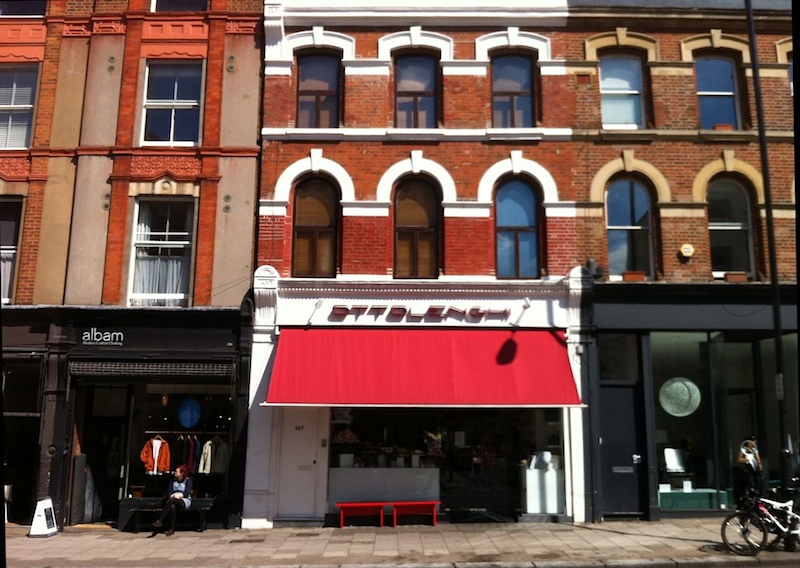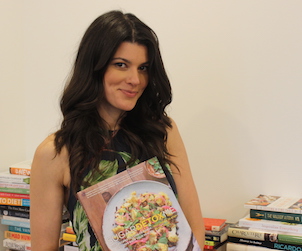One way to consider Ottolenghi (the London restaurants, not the man for whom they’re named) is to think of it as the world’s best salad bar. I don’t mean that pejoratively. It was with a sense of awe and wonder that I dined at the Islington location and realised that a) I had just spent the equivalent of $25 for a plate topped with a collection of cold vegetables; and b) I thought it was worth every penny, especially washed down with a crisp Soave from their ecclectic wine list. These were good vegetables: crucifers, dark leafy greens, grains of quinoa that had been transformed from obligatory fibre and vitamin delivery agents into foods of exotic pleasure. OK, I thought, now I get it.
What I got is the Ottolenghi magic, which has charmed London for more than a decade since Yotam Ottolenghi and Sami Tamimi opened their first restaurant and deli in Notting Hill in 2002. Last year, with the publication of their last book Jerusalem (about which I interviewed the chef-business-partners here), they also charmed North America, as the book debuted at #2 on the New York Times Bestseller List.. They and their vegetable-heavy cuisine are, in other words, on trend and in demand across the Anglosphere. To capitalize on their recent success in the Western Hemisphere Random House has just published an ‘American Edition’ of the duo’s first cookbook, 2008’s Ottolenghi: The Cookbook.
 More than Jerusalem, Ottolenghi: The Cookbook features recipes that resemble the sort of food served at Ottlenghi: The Restaurant I Had Lunch At. The Islington location is set on what the English call a high street among fancy stores, gastropubs and cafés. It’s a long storefront. Inside the door, behind the large window facing the street, where at 1:30 on a Friday afternoon you will wait 20 or so minutes for a seat, is a table on which are set a number of large bowls and plates. In these bowls and on these plates are the kind of dishes featured in the Ottolenghi book: ‘Grilled cauliflower with tomato, dill and capers’, ‘Mixed mushrooms with cinnamon and lemon’, or ‘Camargue red rice and quinoa with orange and pistachios’. There will also be some thinly sliced fish, like salmon and tuna and maybe rare beef. Once you are seated, most likely at the long communal table that makes up most of the restaurant, your server will take your order and go fill your plate from the table in the front. This is what I mean about the salad bar: and, in fact, everything is also for sale to take away.
More than Jerusalem, Ottolenghi: The Cookbook features recipes that resemble the sort of food served at Ottlenghi: The Restaurant I Had Lunch At. The Islington location is set on what the English call a high street among fancy stores, gastropubs and cafés. It’s a long storefront. Inside the door, behind the large window facing the street, where at 1:30 on a Friday afternoon you will wait 20 or so minutes for a seat, is a table on which are set a number of large bowls and plates. In these bowls and on these plates are the kind of dishes featured in the Ottolenghi book: ‘Grilled cauliflower with tomato, dill and capers’, ‘Mixed mushrooms with cinnamon and lemon’, or ‘Camargue red rice and quinoa with orange and pistachios’. There will also be some thinly sliced fish, like salmon and tuna and maybe rare beef. Once you are seated, most likely at the long communal table that makes up most of the restaurant, your server will take your order and go fill your plate from the table in the front. This is what I mean about the salad bar: and, in fact, everything is also for sale to take away.
There is more than just salads in Ottolenghi: The Cookbook. A third of the book is taken over by meat ad fish recipes (‘Roast chicken with sumac, za’atar and lemon’ and ‘Sardines stuffed with bulgur, currants and pistachios’), and another third by pastries and desserts (‘Jerusalem artichoke and Swiss chard tart’ and ‘Semolina and raspberry tart’). It’s a beautiful book full of good ideas, and fans of the Ottolenghi and Samimi’s Jerusalem book will enjoy it, as will newcomers to their new Middle-Eastern cooking sensibilities.
 Malcolm Jolley is a founding editor of Good Food Revolution and Executive Director of Good Food Media, the company that publishes it. Follow him at twitter.com/malcolmjolley
Malcolm Jolley is a founding editor of Good Food Revolution and Executive Director of Good Food Media, the company that publishes it. Follow him at twitter.com/malcolmjolley








